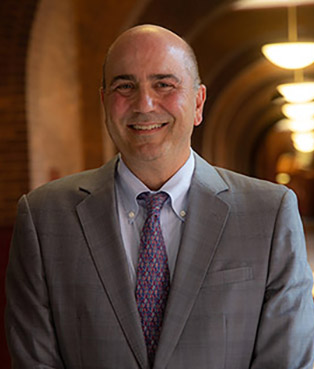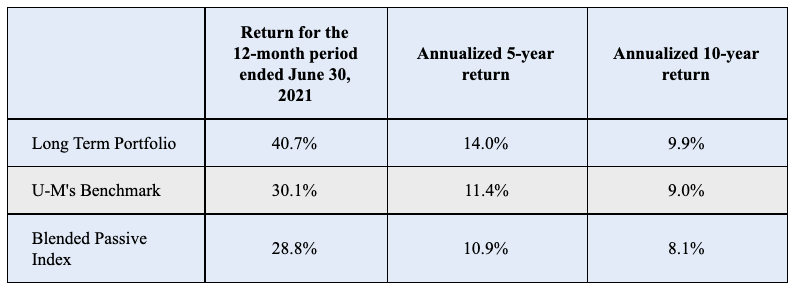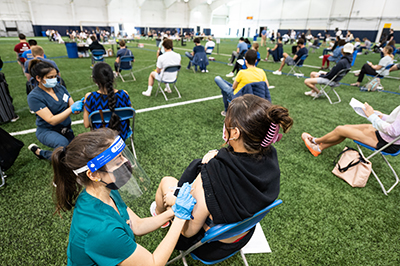Chief Financial Officer's Report

I was very pleased to join the University of Michigan in October 2021 as executive vice president and chief financial officer. In the short time that I’ve been here, I have been extremely impressed by the university’s people and their focus on enhancing U-M’s missions of education, research and patient care while providing excellent stewardship of its financial resources. As the global COVID-19 pandemic extended into FY 2021, U-M employees went to great lengths to ensure the university was able to continue operating effectively while working to contain costs and safeguard the well-being of its community.
MAINTAINING A STRONG FINANCIAL POSITION
Many of the stabilization measures that were implemented when the pandemic began, such as suspending nonessential expenditures and implementing a hiring freeze for all but essential positions, continued throughout the year. In addition, employee base salaries were not increased in FY 2021. These measures, along with increased patient care revenues, stable tuition and research revenues as well as federal economic relief funds, helped contribute to an improved operating performance in FY 2021.
U-M’s net position increased $5 billion in FY 2021 to $19.5 billion, primarily due to substantial investment returns as financial markets experienced tremendous growth following the impact of the pandemic-induced slowdown from the prior year. While net investment income is expected to be volatile from year to year, our endowment distribution policy and long-term investment strategy are designed to insulate the university from this volatility and provide dependable annual support for operations.
The university’s endowment distribution policy smooths the impact of volatile capital markets by providing for annual distributions of 4.5 percent of the seven-year moving average fair value of the endowment. This policy, along with the endowment’s growth, allowed for distributions of $404 million to support university operations in FY 2021, for a total of $1.8 billion over the past five years.
Endowment funds, which are invested principally in the university’s Long Term Portfolio, totaled $17 billion at June 30, 2021. Distributions from more than 12,000 individual endowments provide ongoing and dependable support for a variety of academic, health-related and other needs across the university such as student scholarships, professorships, clinical operations and research.
The table below summarizes the investment performance of the university’s Long Term Portfolio in relation to comparative benchmark portfolio returns.
INVESTMENT PERFORMANCE

DIVERSIFICATION IN REVENUE STREAMS
The University of Michigan has focused on revenue diversification for many years. This model has enabled the institution to be financially stable through various economic cycles and challenges while avoiding unnecessary dependence on student tuition and fee increases. The components of the university’s sources of revenue are depicted below.
U-M continues to rely on funding from the state of Michigan as an integral source of financial support. In FY 2021, state educational appropriations returned to pre-pandemic levels and totaled $373 million. We are extremely grateful to the residents of the state of Michigan for their ongoing support of higher education and the University of Michigan. This support is particularly meaningful in light of the ongoing challenges that U-M faces as a result of the COVID-19 pandemic. Beyond that, the success of higher education is crucial to the state’s economic health as it works to emerge from the pandemic.
The university’s operating budget has always balanced academic excellence and investment in the future with student affordability and access. Tuition rate increases for FY 2021 were 1.9 percent for both resident and nonresident undergraduate students and most graduate programs on the Ann Arbor campus. Tuition rate increases for most resident undergraduate students on the Dearborn and Flint campuses were 1.9 and 3.9 percent, respectively.
The FY 2021 budget also included a 5.6 percent increase in financial aid for undergraduates on the Ann Arbor campus and an 11.8 percent increase in institutionally awarded financial aid for UM-Dearborn. Due to continued growth in non-tuition revenues and a longstanding commitment to controlling costs and improving efficiencies across its operations, the university has been able to limit tuition increases and provide generous financial aid.
The demand for a University of Michigan education continues to grow, with more than 90,000 prospective first-year-student applications — a record number — submitted from around the world for its three campuses. This marks the 14th consecutive year that applications have increased. The institution has had a stellar reputation around the globe for generations. That reputation, along with the outstanding value offered by U-M, make the university a top destination for exceptional students from Michigan, the United States and countries around the world.
ADDRESSING THE WORLD’S CHALLENGES THROUGH RESEARCH
The largest external sponsor of U-M research is the National Institutes of Health, and during FY 2021, this federal agency supported several projects that explored the causes, diagnoses and prevention of the novel coronavirus. Our researchers collaborated across disciplines to identify treatments for the virus, improve personal protective equipment and study how the pandemic exacerbated health inequalities within our communities.
U-M consistently ranks among the world’s largest research universities and its vast volume of research expenditures totaled nearly $1.6 billion in FY 2021. More than half of the university’s annual research volume is sponsored by the federal government, including $894 million in FY 2021. This year, U-M research also helped generate 502 new inventions and launch 23 start-up companies.
MICHIGAN MEDICINE PROACTIVELY ADDRESSES COVID-19 CHALLENGES

Several COVID-19 surges strained Michigan Medicine’s teams, and its vaccine rollout was hampered by supply constraints. Through it all, however, we were resilient — while preserving the highest standards of quality and safety for both our patients and our staff. Michigan Medicine successfully worked to efficiently use its capacity for surges of COVID-19 patients while balancing the needs of non-COVID-19 patients. Teamwork, access, safety and quality were continuous priorities for our patients and employees.
Despite these pandemic-related challenges, UMHS experienced positive FY 2021 results, with a 2.3 percent — or $108 million — operating margin on operating revenues of $4.8 billion. UMHS also received federal pandemic relief funding of $134 million. These positive FY 2021 financial results put UMHS back on track to meet expectations after FY 2020 operating losses.
This year’s positive financial performance enables investment in the future, which includes resuming construction of a new hospital. Known as The Pavilion, this new 12-story hospital will house 264 private rooms capable of converting to intensive care, a state-of-the-art neurological and neurosurgical center, high-level specialty care services for cardiovascular and thoracic patients and advanced imaging services. Construction resumed on the 690,000-gross-square-foot building in spring 2021, which is expected to open in fall 2025.
A BRIGHT FUTURE

The university — as part of its continued effort to maintain excellence in education, research and patient care and offer collaboration opportunities for multiple disciplines — has always made important capital investments in a wide variety of its facilities. And, despite the pandemic’s impact on the supply chain and employment across many industries, U-M did complete a number of key projects in FY 2021, including the new Ford Motor Company Robotics Building and the renovation and expansion of the UM-Dearborn Engineering Lab Building.
An overview of the capital projects completed, in progress and in planning during FY 2021 appears in the Major Projects section. U-M has long balanced investments in new facilities against the renewal of existing facilities, a model that enables the institution to avoid an excessive accumulation of deferred facility maintenance.
I hope you’ll take some time to review Management’s Discussion and Analysis (PDF) in conjunction with the audited financial statements. This section of the annual report offers more details about U-M’s financial strength, prudent financial policies and commitment to excellence. When combined with the ongoing efforts of our dedicated employees, these key factors allow the university to continue its longstanding commitment to making the world a better place while navigating the challenges posed by the global COVID-19 pandemic.
Our tenacious focus on fiscal prudence has enabled the institution to conclude FY 2021 in an exceptionally strong financial position. And while we remain cautious on a number of fronts because the pandemic continues to affect U-M in a multitude of ways, we’re extremely optimistic about the future of the university.
Sincerely,

Geoffrey S. Chatas
Executive Vice President and Chief Financial Officer
